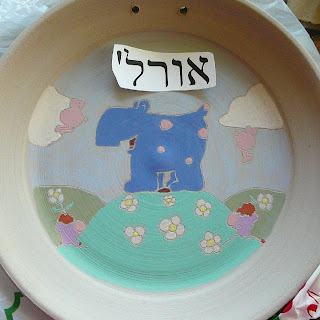
Here are the pieces and a bit of the thought behind them. The photo precedes the explanations for the pieces.:

Charoset - Charoset symbolizes the mortar with which the Israelites bonded bricks when they were enslaved in Ancient Egypt. The word Charoset comes from the Hebrew word cheres which means clay. In the representational set, the charoset is held the bowl with bricks impressed on the outside.
Karpas – There is a green, leafy vegetable (usually celery or parsley/lettuce) called karpas which reminds the participants that Passover corresponds with Spring and the harvest, which, in ancient times was a cause for celebration by itself. A more contemporary interpretation links karpas with the biblical description of the Hebrew slaves marking their doorposts at the time of the first Passover. A bunch of hyssop was to be dipped in the blood of the paschal lamb and used to strike the lintel and the doorposts (Exodus 12:22) so that the tenth plague (death of the firstborn) would not be visited upon their households. In the representational set, karpas is symbolized by a container mimicking the wood of the doors and the crossbeam of the lintel over that door.

Maror and Chazeret – The word maror comes from the Hebrew word mar, which means bitter. The seder plate usually contains two places for maror (bitter herbs), representing the bitterness of slavery. There are two places, called maror and chazeret, since the commandment (Numbers 9:11) to eat the paschal lamb "with unleavened bread and bitter herbs" uses the plural ("bitter herbs"). In the representational set, the maror and chazeret are linked by the use of a yoke and rope, symbolizing the years of slavery our people endured.

Zeroa – The zeroa (roasted shank bone) represents God's mighty arm when he freed the jews from slavery in Egypt. The zeroa is also symbolic of the Paschal lamb offered as the Passover sacrifice in the Jerusalem Temple. The platform altar is the representational piece in this set.
Baytzah – The seder also uses a hard-boiled egg called a baytzah which represents the second offerings given at the temple in Jerusalem on Passover, Shavuot, and Sukkot. The roasted egg is symbolic of the festival sacrifice made in biblical times. On Passover, an additional sacrifice (the Paschal lamb) was offered as well. In the representational set, the nest holds the baytzah (egg).

Salt Water – During the course of the Seder, the karpas is dipped in salt water to represent tears. The set includes a tear-shaped bowl with colors mimicking the different depths of the Red Sea.


























